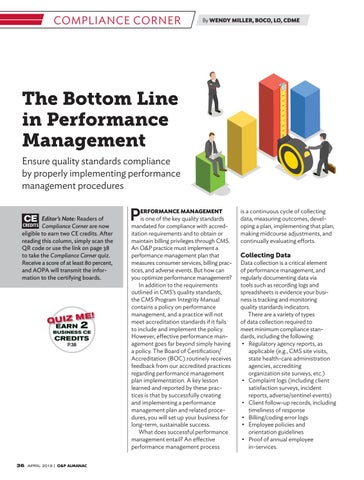COMPLIANCE CORNER
By WENDY MILLER, BOCO, LO, CDME
The Bottom Line in Performance Management Ensure quality standards compliance by properly implementing performance management procedures Editor’s Note: Readers of CREDITS Compliance Corner are now eligible to earn two CE credits. After reading this column, simply scan the QR code or use the link on page 38 to take the Compliance Corner quiz. Receive a score of at least 80 percent, and AOPA will transmit the information to the certifying boards.
CE
E! QU IZ M EARN
2
BUSINESS CE
CREDITS P.38
36
APRIL 2019 | O&P ALMANAC
P
ERFORMANCE MANAGEMENT
is one of the key quality standards mandated for compliance with accreditation requirements and to obtain or maintain billing privileges through CMS. An O&P practice must implement a performance management plan that measures consumer services, billing practices, and adverse events. But how can you optimize performance management? In addition to the requirements outlined in CMS’s quality standards, the CMS Program Integrity Manual contains a policy on performance management, and a practice will not meet accreditation standards if it fails to include and implement the policy. However, effective performance management goes far beyond simply having a policy. The Board of Certification/ Accreditation (BOC) routinely receives feedback from our accredited practices regarding performance management plan implementation. A key lesson learned and reported by these practices is that by successfully creating and implementing a performance management plan and related procedures, you will set up your business for long-term, sustainable success. What does successful performance management entail? An effective performance management process
is a continuous cycle of collecting data, measuring outcomes, developing a plan, implementing that plan, making midcourse adjustments, and continually evaluating efforts.
Collecting Data
Data collection is a critical element of performance management, and regularly documenting data via tools such as recording logs and spreadsheets is evidence your business is tracking and monitoring quality standards indicators. There are a variety of types of data collection required to meet minimum compliance standards, including the following: • Regulatory agency reports, as applicable (e.g., CMS site visits, state health-care administration agencies, accrediting organization site surveys, etc.) • Complaint logs (including client satisfaction surveys, incident reports, adverse/sentinel events) • Client follow-up records, including timeliness of response • Billing/coding error logs • Employee policies and orientation guidelines • Proof of annual employee in-services.
